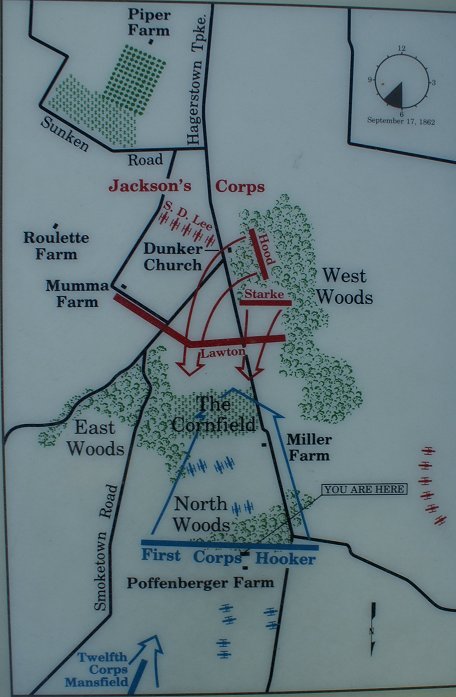
Antietam - Union I Corps Attacks
September 17, 1862

Hooker Attacks From the North Woods
|
 |

From Hagerstown Pike
This is the view from the Hagerstown Pike, which followed the axis of the Union advance. From here, you can get a better idea of the rolling nature of the ground.

From Near Southern End of the East Woods
The Confederate line, stretched from the area of the Mumma farm to the Smoketown Road, then through the field behind the Cornfield. In this field, the line pivoted and continued across the Hagerstown Pike to near where the West Woods monument to the Philadelphia Brigade now stands. Southern skirmishers were sent forward to the Cornfield, and Hood's division was in reserve near the Dunker Church.
Rickett's division emerged from the East Woods to attack in this area. Confederates had burned the Mumma house to keep it out of the hands of snipers, and the southerners took cover behind the stone walls of the Mumma cemetery. The battle raged between the Mumma's and the West Woods.

From Near Dunker Church
In this view, the Confederate line would have stretched from the West Woods near the post-war farm on the left to the Road to the Mumma farm on the right. In confused fighting, the Confederate line had all it could take. Doubleday's division in the West Woods flanked the left of the Confederate line, and Ricketts' division from the East Woods flanked the right. The Confederate line was forced back from its position into the West Woods and into the V between the Hagerstown Turnpike and the Smoketown Road. Union troops advanced toward the Dunker Church. Starke's and Taliaferro's brigades moved out of the West Woods and took up position at the rail fence along the Hagerstown Pike - near the post war house at top of the hill. These Confederates raked Gibbon's Iron Brigade at 30 yards but suffered fearfully as the Yankees wheeled to face them while Union artillery up the road enfiladed them. Additional Union troops attacked their exposed flank. These Rebels were forced back, and Hooker's corps continued toward the Dunker Church.
It was only 7 A.M., and Hooker's men were 200 yards from the church. One third to half of the men in the two Confederate divisions opposing Hooker were casualties, and Stonewall Jackson had only Hood's division of 2,300 men left in reserve. He had no choice but to commit this reserve. Hood's men had been eating breakfast, and they were annoyed by the interruption. They took it out on the Federals. Hood's men, in the brigades of Wofford and Law deployed and charged with such a fury that they were not stopped until they reached the northern edge of the Cornfield.

Western End and Southern Edge of the Cornfield
This is the view from near the western end of the Cornfield along the Hagerstown Pike. Hooker's I Corps had attacked from the North Woods beyond the Cornfield, only to be pushed back by Hood's division. Hood's men reached the northern edge of the Cornfield, becoming stretched out. The men of Law's brigade reached at the north-eastern corner of the Cornfield near the East Woods. In this area, the 18th Georgia and 4th Texas were threatened on their left as they advanced, so they wheeled left and remained near the modern intersection on the left of the panorama and faced the flanking Yankees across the Hagerstown Pike. The guns barely visible here across the Hagerstown Pike mark the position of Battery B, 4th US Artillery, or Campbell's battery. These guns are near the northern edge of the Cornfield, where the main Union line stood. When the Federals across the Pike began to fall back, the 1st Texas continued forward into the Cornfield 200 yards in advance of the rest of the brigade. The 1st Texas took fire from three sides, including from the Union artillery at the Pike and lost 82% of its men that day, the highest percentage loss of any Confederate regiment for a single day.
Pressured here and in the East Woods on the other flank, the Confederates of Hood's division would be forced back into the West Woods.

Cornfield
By now, the Cornfield was a wreck, with the corn nearly stripped to the ground and bodies arranged in the lines in which the men had fought. Lawton's division had lost half its men. Hood had lost close to 60% of his division. Hooker lost 2,600 men from his corps, with Ricketts' division loosing so many to straggling that just over 300 men were accounted for from the original 3,150. On both sides, those who survived were in little condition to continue the fight. Mansfield's XII Corps was on the way, though.
Copyright 2008 by John Hamill